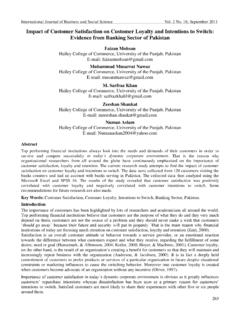Transcription of The Effectiveness of Protocols in Emergency Departments …
1 EFFECTIVE Protocols IN Emergency Departments 1. The Effectiveness of Protocols in Emergency Departments By: Hailey Bracey Central Magnet School Acknowledgements EFFECTIVE Protocols IN Emergency Departments 2. I would first like to thank my Biomedical Innovations teacher, Mrs. Eve Harrison, for her instruction and supervision of my thesis. Mrs. Harrison was always available and qualified to help format and revise my thesis. This research would not be what it is without her support and critiques throughout the year. I would also like to thank my English teacher Mrs. Lynne Maxwell for encouraging me throughout the thesis process and helping me to revise my background research and introduction.
2 Also, to my advisor Ms. Heather Corban who encouraged me throughout the year and read over many parts of my thesis. I would also like to thank Sharon Cox from St. Thomas Medical Center and Cynthia Adams from Stonecrest Medical Center for being willing to help with my thesis surveys. Without their willingness to send surveys, I wouldn't have any as many results as I do now. Next, I would also like to thank St. Thomas Rutherford Hospital for allowing the Biomedical Innovations class from Central Magnet to tour their Emergency room. The tour really helped me figure out ideas for my thesis and focus my research.
3 The hospital's Emergency room layout helped me to see the advantages and disadvantages to many Emergency rooms in the world and also create my own layout. Finally, I would like to thank MTSU for allowing me to use their private databases for thesis research. I found multiple articles while at the MTSU library that were very helpful towards my research and development throughout this paper. My background information would not be as in depth as it is now without those resources. Table of Contents ABSTRACT ..4. EFFECTIVE Protocols IN Emergency Departments 3. INTRODUCTION 4-11.
4 RESEARCH QUESTION ..4. RESEARCH PURPOSE 4. BACKGROUND. INFORMATION ..5. HYPOTHESIS ..11. METHODOLOGY ..11-12. RESULTS ..12-15. PATIENT EXPERIENCE SURVEY ..12- 14. PHYSICIAN EXPERIENCE SURVEY .14- 15. DISCUSSION .. 15-16. CONCLUSION ..16-17. APPENDIX A ..18-19. APPENDIX B ..20-22. REFERENCES ..23-25. Abstract EFFECTIVE Protocols IN Emergency Departments 4. The purpose of this research is to determine if Emergency department Protocols are set accordingly to best benefit patients and if so, how they can continue to be improved. This study is mainly focused on Protocols involving patient flow of information, ER layout, wait time, and upkeep of facilities.
5 Research shows that Emergency Departments are always improving and continuing to grow, but are they doing it to most effectively benefit all types of patients that walk through the ER doors? Jim Crispino, the president of Philadelphia-based firm Francis Cauffman believes that the Emergency department is a pivotal component to the rest of the hospital's success. (Dickinson, E. E., 2007) Without an ER, the population in the surrounding area would be in danger, but also the rest of a hospital would overall be a lot less successful. People of all ages took part in a survey asking about their personal experiences in an Emergency department.
6 The results showed that most people don't have a great 5/5 experience, but they also don't have a terrible experience either. The participants continued to agree that there are many things that should be improved in an ER, but most also understood a lot of the limitations that hospitals have within their Emergency Departments including things like money and space. Based on all of the results, there are ways that Emergency department can be improved, like implementing a new design of the ER, a new flow of information, or new ways to get funding for the things they need to adjust or correct the department.
7 It is important for hospital employees and the surrounding population of a hospital to know how important an Emergency department is to themselves and the rest of the hospital so it can best benefit the patients who enter on a daily basis. Introduction Research Question How can Emergency department Protocols and guidelines be improved or altered so all processes in the department run smoothly and effectively? Research Purpose The purpose of this study is to determine if the Protocols and layout of Emergency Departments are set appropriately to benefit patients in the best way.
8 All Protocols in Emergency Departments are set reasonably for each patient's medical experience and their well-being. The intent of this study is to try and find different ways to alter them for a better patient experience. Studies have shown specific changes in Emergency Departments are effective. This study will offer a few aspects of the Emergency department, rather than just being focused on one. Patient experience versus physician responsibility is taken into account along with the difference between pediatric and adult Protocols and Emergency department layout.
9 The Emergency EFFECTIVE Protocols IN Emergency Departments 5. department is very functional and always developing; this research is introducing possible improvements to its Protocols and layout. Background Information There is a common theme throughout all of the sources and studies in this research of how Emergency rooms function. Whether Emergency Departments are functioning poorly or remarkably, there is always room for improvement. A study was done at a University Medical Center in Germany to implement new Protocols in their Emergency rooms. After analyzing the existing Protocols in their Emergency rooms, the department of anesthesiology of the Medical University of Gottingen (UMG) developed new Emergency room Protocols that were department-specific.
10 As as result, they created 13 different sections to represent the protocol and its contents; general characteristics, Emergency event, initial findings and interventions, vital parameters, injury pattern, vascular access, hemodynamics, hemogram/blood gas analysis (BGA), coagulopathy, diagnostics, Emergency interventions, termination of ER treatment and final evaluation. (Ross, Hinz, Mansur, Mielck, Roessler and Quintel, 2015) This study is useful because it gives a completely different perspective of hospital Emergency rooms and the list of things they choose to improve.





